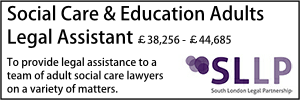Court of Appeal finds judge fell into errors of principle when making finding of ‘inflicted injuries’
- Details
The Court of Appeal has allowed an appeal against a judge’s findings that fractures to both the tibias of a 10 month old girl had been inflicted either deliberately or recklessly by either her mother or father.
In W (A Child), In the Matter Of (Inflicted Injury - Delay) [2024] EWCA Civ 418 (26 April 2024), Lady Justice King concluded that the judge fell into “a number of errors of principle”, and that the threshold criteria were not satisfied.
The proceedings concerned a little girl, W, who was born prematurely at 33 weeks towards the end of November 2020.
King LJ said: “By reason of her prematurity, W remained on the neonatal intensive care unit for a period of a little over three weeks and for the first four days of her life was in receipt of Total Parenteral Nutrition, a process of administering highly specialised forms of food intravenously.”
From 11 February until the end of September 2021, a consultant paediatrician prescribed Omeprazole, a proton pump inhibitor ('PPI') used in the treatment of indigestion and acid reflux, which W was suffering from.
In due course, W’s mother returned to her part time work as a teaching assistant. Arrangements were made whereby W was taken to the home of the grandmother and maternal step-grandfather three mornings each week.
Shortly after W's arrival, the grandmother herself would leave to go to work leaving W in the care of her step-grandfather.
On 30 September 2021, the step-grandfather moved a few steps away from the sofa where he was changing W in order to dispose of a dirty nappy, when W rolled from the sofa and landed awkwardly. W was distressed and her leg was clearly hurt.
“The family acted entirely appropriately. The step-grandfather rang W's parents and within an hour W was taken to the Walsall Manor Hospital. Following an X-ray, W was found to have sustained a fracture to her right femur”, said King LJ.
The medical professionals accepted that, whilst unusual for a baby to sustain such an injury from a low-level fall, the femoral fracture was an accidental injury.
However, whilst at hospital, a skeletal survey was carried out which revealed that W had, in addition to her femur fracture, fractures to her left and right tibias which radiologically were shown to be a little older than the femur fracture.
Neither the parents nor the grandparents were able to give any history or explanation as to how the fractures had occurred, which raised concerns about the possibility of inflicted injury, said King LJ.
The local authority issued care proceedings and W was made the subject of an interim care order on 8 October 2021. W was placed into foster care where she remains to date.
Turning to the trial, King LJ said the local authority submitted that the two tibial fractures were “inflicted injuries” and that each of the four family members was a potential perpetrator.
The trial judge heard evidence from a pharmacologist Dr Sharp, Dr Shenoy (a consultant paediatrician), both of the parents, the grandmother and step-grandfather.
King LJ said: “The judge identified what he regarded as the significant issue at para [52] as follows:
"the significant issue that I need to consider and arrive at conclusions on arise from whether [W] had bone fragility arising from her prematurity, (including low birth weight), her extended period in NICU, her TPN feeding and problems with feeding on discharge from hospital."
She added: “The judge went on at para [54] to say that another issue he was going to have to consider was W's "likely reaction to having sustained tibial fractures”. […] At paras [125] and [127], the judge exonerated the grandparents and found that the tibial fractures had been inflicted by either the mother or the father.”
The grounds of the present appeal were submitted on behalf of the mother as follows (summarised by the Court of Appeal judge):
i) The judge gave insufficient weight to the accidental femur fracture and failed to consider it as part of the analysis of whether the child had fragile bones.
ii) The court failed to consider the cumulative impact of the possible causes of bone fragility and instead evaluated the evidence in compartments rather than as a whole.
iii) The judge placed excessive weight on the evidence regarding pain response and reversed the burden of proof onto the parents.
iv) The judge placed too much emphasis on the evidence of Dr Sharp and failed to analyse the significance of the exclusion of W from the study.
v) The judge failed to place sufficient weight onto the wider canvas and in particular the total absence of risk factors surrounding the parents or the wider family.
Looking at the medical evidence considered in the trial, Lady Justice King said that Dr Olsen (the paediatric radiologist) explained that W's injury pattern was “quite unusual” in that the fractures seen in the tibias were all commonly caused by weight bearing. Fractures of this type seen in tibial bones are often called "trampoline fractures" because of the typical mode of causation in older children.
Dr Shenoy (the paediatrician) said in his report that W was on Omeprazole for over seven months at the time of her presentation which "can cause increased risk of fractures". Further, he explained in his written report that premature infants who spend a prolonged period in the neonatal unit do have bone fragility.
Lady Justice King said: “The parents subsequently provided photos and videos of W weight bearing and jumping on her ‘Jumperoo’. Dr Shenoy in his oral evidence agreed that W bouncing in her Jumperoo would be sufficient to cause the tibial fractures (described by Dr Olsen as trampoline fractures) if there was bone fragility.”
The court on 27 May 2022 directed the instruction of an expert pharmacologist, Dr Stephanie Sharp, in order to consider whether W had an increased risk of fracture.
Dr Sharp's evidence relied substantially upon a paper: Early Acid Suppression Therapy Exposure and Fracture in Young Children by Laura Malchodi et al ('the Malchodi paper').
The paper looked at a cohort of 851,631 children. Only children without known serious medical conditions were included in the study.
The Court of Appeal judge noted it was “common ground” that W would have been excluded from the study as: she was premature, had been in the neonatal unit for three weeks, was of a much lower birth rate than the babies in the study, had been prescribed Omeprazole for far longer than the children in the study and had suffered a fracture before one year of age.
Dr Sharp concluded that there is a “small risk” of all fractures over a period of time in children treated with PPIs such as Omeprazole and that the risk may be increased with increased duration of treatment.
The Malchodi paper, she said, indicated the median age for fracture to be 3.9 years, which would suggest that any risk of fracture would occur in an older child and not imminently in a baby in receipt of the medication.
Lady Justice King said: “Whilst she did not discount the possibility that Omeprazole might have been a contributory factor in relation to W's fracture risk, and she accepted that W having had Omeprazole for over seven months placed W in a higher risk category than the children in the study, Dr Sharp maintained her opinion that on the balance of probabilities Omeprazole was not causative of the fractures by reason of bone fragility in W's case.”
The trial judge concluded he was satisfied that Dr Sharp's opinion that Omeprazole did not cause or contribute to W sustaining fractures was "well made out on the totality of the evidence", and that W did not have any bone fragility at the time when she sustained her fractures.
King LJ found that the judge “fell into error” in analysing the medical evidence in “closed off compartments” and as a result, “failed to consider the relevance of the accidental femur fracture and the cumulative impact of the various possible causes of bone fragility” (as asserted in Grounds 1, 2 and 4).
She said: “The judge's acceptance of Dr Sharp's central reliance on the fact that the healthy babies in the Malchodi paper sustained their fractures at a median age of 3.9 years singularly failed to take into account the fact that this baby had had what was accepted to be a highly unusual accidental fracture to her femur at 10 months of age when she was still being prescribed Omeprazole.”
Turning to ground 3 of the appeal, King LJ found that the judge placed “excessive weight” on the issue of W’s pain response, without any reference to the evidence given by the parents or grandparents.
In evidence, Dr Shenoy had said that he would “invariably have expected W to demonstrate pain at the time (of the fractures) and to have shown some distress thereafter”. However, a ‘clinically silent’ fracture was a possibility.
King LJ said: “Unfortunately, despite having reminded himself that the evidence of the parents was of the utmost importance, nowhere in the judgment does one find any summary or understanding of the evidence given by the parents. All that is to be found is a general observation that there was no evidence from anyone who had cared for W of an occasion when she cried out or was distressed, other than when she sustained the femur fracture and also that the father had accepted that W would have been distressed.”
Concluding the case, the Court of Appeal judge said: “This was undoubtedly a difficult and complex case which would have been challenging for any judge to navigate. The judge, focused as he was on the evidence of Dr Sharp and his understandable concern at the seemingly lack of any history or description of pain or distress exhibited by W following the tibial fracture, reached the conclusion that these were inflicted injuries.
"I am satisfied that a proper analysis of all the features of the case could only have led to the conclusion that the entirety of the evidence demonstrated that the burden on the local authority to satisfy the court that inflicted injury was more likely than not to be the cause of the tibial fractures had not been discharged. In those circumstances the Court concluded that it was neither necessary nor appropriate to remit the case for a retrial.
“It follows that the threshold criteria under section 31(2) of the CA 1989 were not satisfied, it not having been established that W suffered significant harm attributable to the care given to her by either her mother or her father such care not being what it would be reasonable for them or either of them to have given to her.”
The interim care order was discharged and the proceedings discontinued.
Lord Justice Baker and Lord Justice Underhill agreed.
Lottie Winson









































